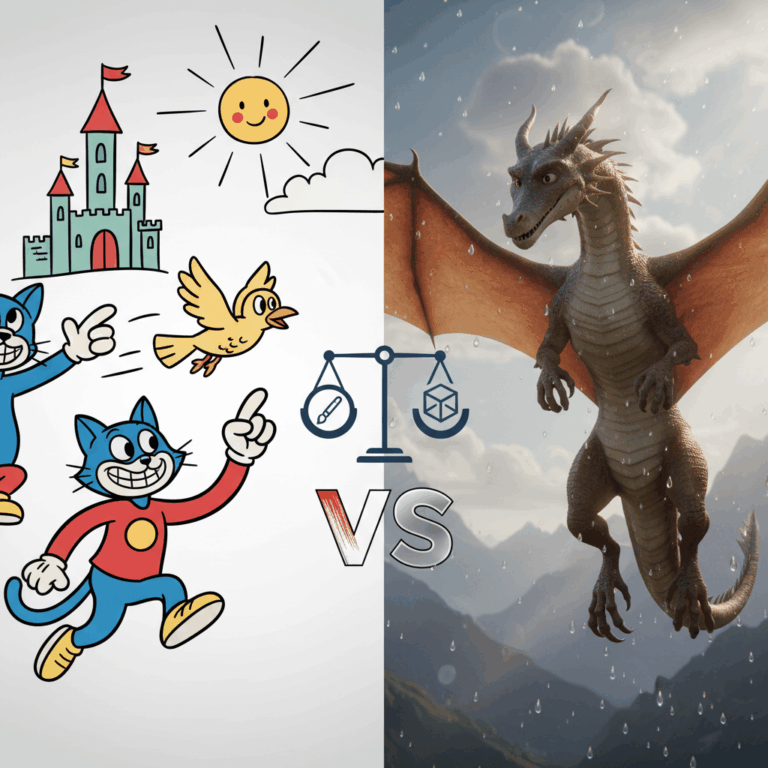Main differences between 2D and 3D animation
The 2D animation It is based on flat images with two dimensions: height and width, creating a more stylized and artistic effect.
In contrast, the 3D animation It adds depth, using three-dimensional models that offer realism and visual detail.
Both techniques have different processes and tools that influence the production and the final result of the animation.
Perception of depth and dimension
2D animation presents a two-dimensional space without depth, giving a flat but expressive and stylized appearance.
On the other hand, 3D animation uses models with depth that allow for realistic visual effects, such as shadows and camera movements.
This facilitates a more immersive experience, ideal for scenarios that require volume and visual realism.
Production processes and tools
In 2D, each frame is usually drawn by hand or with specialized software, requiring traditional artistic skills.
3D animation involves modeling and animation in virtual environments, using advanced software and hardware to create reusable objects.
While 2D is usually faster and cheaper, 3D requires more investment, learning time, and technological equipment.
Specific advantages of each technique
2D animation offers a more agile and economical production, ideal for projects with time and budget constraints.
Furthermore, it allows for great artistic freedom that favors expressive styles and symbolic or fantastical narratives.
Benefits and applications of 2D animation
2D animation is recognized for its lower cost and relative speed in production, facilitating the creation of series and short films.
Its flat and expressive style is perfect for independent video games and projects that require an artistic and cartoonish aesthetic.
This makes it very useful in products where simplicity and visual creativity take priority over realism.
Advantages and uses of 3D animation
3D animation stands out for its ability to achieve impressive visual realism through depth and volumetric detail.
It allows you to reuse models and animate them from multiple angles, offering great flexibility for film productions or advertising.
Although it requires a larger investment, it is ideal for projects that demand impressive visual effects and realistic simulations.
Characteristic visual styles
The visual style of 2D animation is characterized by its flat appearance, vivid colors, and defined lines that highlight expressiveness.
In contrast, 3D animation offers a volumetric style with shadows, textures, and depth that simulate reality.
Both styles have unique qualities that influence the perception and visual impact of animated productions.
Features of the 2D style
2D animation stands out for its flat and expressive graphics, where each frame emphasizes design and artistic creativity.
The colors tend to be bright and simple, favoring a cartoonish or stylized look that connects with symbolic emotions.
This style is ideal for telling abstract and fantastical stories, as it does not depend on visual realism but on visual interpretation.
Visual simplicity facilitates clear and direct communication, increasing accessibility for different audiences.
Features of the 3D style
In 3D animation, the style is based on the creation of objects and characters with depth, volume, and realistic textures.
Shadows, lighting, and camera movements are used to create an immersive and dynamic visual environment, very close to reality.
This approach allows for the representation of complex details and sophisticated visual effects that enhance the spectacular nature of the animation.
The 3D style is preferred in productions that seek a high degree of realism or a striking and modern visual impact.
Factors to consider when choosing between 2D and 3D animation
The choice between animation 2D and 3D It depends on the artistic and narrative goals that the creator seeks to achieve.
The availability of technical and human resources, as well as the complexity of the proposed project, also play a role.
Evaluating these factors is key to defining the most appropriate technique for each audiovisual production.
Artistic and narrative objectives
2D animation is ideal for stories that require an expressive, symbolic, or cartoonish style, where visual creativity predominates.
In contrast, 3D animation favors narratives that seek realism, depth, and impressive visual effects for greater immersion.
The decision is based on how the story is to be told and what kind of visual experience is to be created for the viewer.
Available resources and technical complexity
2D animation usually requires fewer technical resources and can be produced with a smaller budget and basic equipment.
In contrast, 3D animation demands specialized software, powerful hardware, and longer production time for modeling and animation.
In addition, the team's experience needs to be considered, as 3D involves a steeper learning curve.






